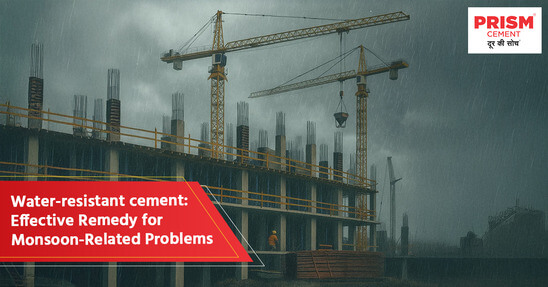
The monsoon season, while bringing much-needed rain, also poses a significant challenge for homeowners and builders alike. Water-related problems in construction can cause long-term damage, especially when buildings are not adequately prepared to withstand the heavy rains. From water leaking from ceilings to dampness creeping into walls, these issues can deteriorate the structural integrity and aesthetics of your home. To combat these monsoon-related challenges, water-resistant cement emerges as an effective and reliable building solution.
In this blog, we will explore water-resistant cement, its benefits, and how it can be used to address common monsoon problems in construction.
It is a specially designed type of building cement formulated to resist water penetration. This type of cement is commonly used in areas prone to water exposure, such as bathrooms, basements, and external walls. The construction chemicals used in it enhance its ability to prevent water from seeping into the structure, thus protecting the building from water-related damage.
Unlike traditional cement, which can absorb water and lose its strength when exposed to moisture, it remains unaffected, providing long-lasting protection against water infiltration.
It works by incorporating water-repellent additives during the manufacturing process. These additives form a barrier within the cement mixture, preventing the cement from absorbing water. As a result, it helps in reducing the risk of water and cement reactions, which can lead to cracks, weakening of the structure, and corrosion of reinforcement bars. This makes it an ideal choice for areas exposed to high moisture levels, especially during the monsoon season.
The cement’s hydrophobic properties ensure that water is repelled, rather than being absorbed into the material, thus offering enhanced durability and performance. Additionally, the cement plaster applied over it further adds to the water-repellent capabilities, protecting both the structure and its surface.
Monsoon rains bring a lot of challenges to buildings that aren't properly protected. Common problems include:
The benefits of water-resistant cement are numerous, especially in monsoon-prone areas. Here’s why it’s a must-have building solution:
The versatility of it makes it an excellent choice for various applications in areas affected by frequent rainfall. Here are some key areas where it can be used:
While traditional cement provides a strong base for construction, it lacks the ability to withstand prolonged exposure to water. Here's a comparison between water-resistant cement and traditional cement:
| Feature | Water-Resistant Cement | Traditional Cement |
| Water Resistance | High; designed to repel water | Low; absorbs water |
| Durability | Higher; prevents water-induced damage | Lower; prone to cracking and corrosion |
| Maintenance | Low; requires less repairs | High; frequent repairs needed |
| Cost | Slightly higher, but cost-effective in long-term | Lower upfront, but expensive in maintenance |
| Applications | Ideal for areas with water exposure | Suitable for dry areas |
To maximize the effectiveness of water-resistant cement, follow these tips:
The monsoon season can wreak havoc on buildings if they aren’t properly protected. Water-resistant cement offers a practical and effective solution to combat water-related issues such as leaks, dampness, and foundation damage. By using it in critical areas of your home, such as external walls, ceilings, and basements, you can ensure long-term durability and reduced maintenance costs.
For the best protection, consider using Prism Champion All Weather GOLDSHIELD Cement, which offers high-quality water-resistance designed to stand the test of time and the harsh weather conditions.
Protect your home from water damage this monsoon with Prism Champion All Weather GOLDSHIELD Cement. Explore how it can enhance your construction’s durability today!
Yes, it is designed to prevent water from seeping through the ceiling, thus stopping water leaks.
PPC cement (Portland Pozzolana Cement) is generally more water-resistant than traditional cement due to its pozzolanic properties, making it suitable for monsoon-prone areas.
It is ideal for external walls, roofs, basements, bathrooms, and kitchens—areas that are regularly exposed to moisture.
While water-resistant cement itself is effective, using construction chemicals such as sealants and coatings in conjunction can further enhance the protection against water damage.
Yes, cement plaster made with water-resistant cement provides a protective barrier against dampness and moisture penetration, keeping walls dry and intact.
Prism Cement a division of Prism Johnson Limited is one of India’s leading integrated Building Materials Company, with a wide range of products from cement, ready-mixed concrete, tiles and bath products.
Prism Johnson Limited is an IMS Certified Company (ISO 9001:2015, ISO 14001:2015, ISO 45001:2018,SA 8000:2014 & ISO 50001:2018). Quality assurance is an integral part of Prism Johnson Limited manufacturing philosophy. The strength and other characteristics are much higher than the BIS requirements. Excellent quality has placed Prism Cement in the premium price segment.
KNOW MORE305, Laxmi Niwas Apartments, Ameerpet,
Hyderabad - 500016, Andhra Pradesh
![]() Tel: +91-40-23400218
Tel: +91-40-23400218
![]() Fax: + 91-40-23402249
Fax: + 91-40-23402249
"Rahejas", Main Avenue, V.P. Road,
Santacruz (W), Mumbai - 400054,
Maharashtra
![]() Tel: +91-40-23400218
Tel: +91-40-23400218
![]() Fax: + 91-40-23402249
Fax: + 91-40-23402249